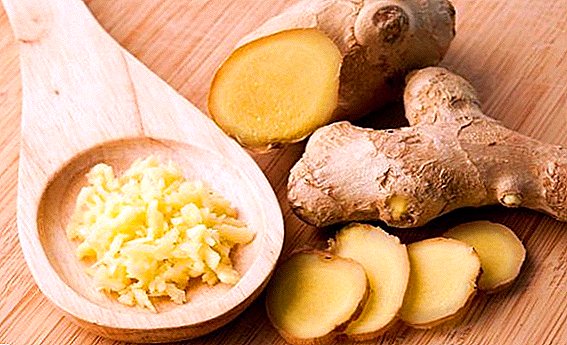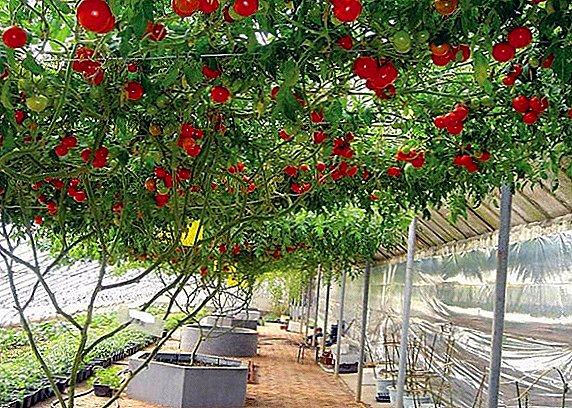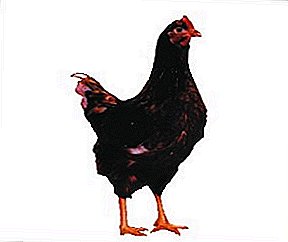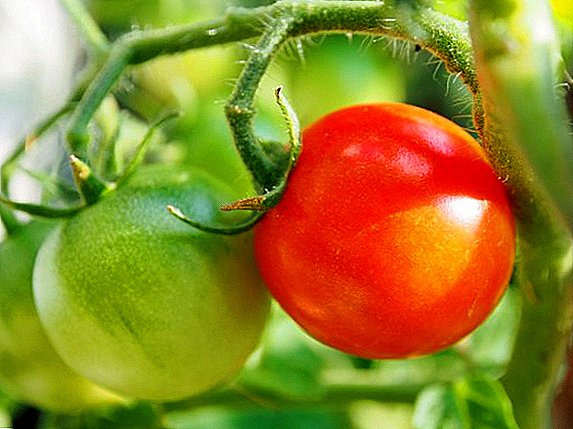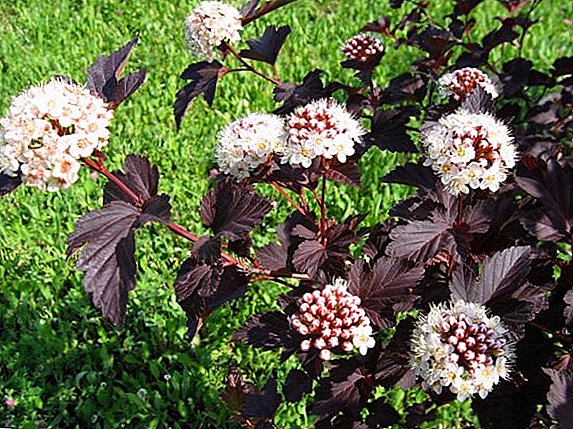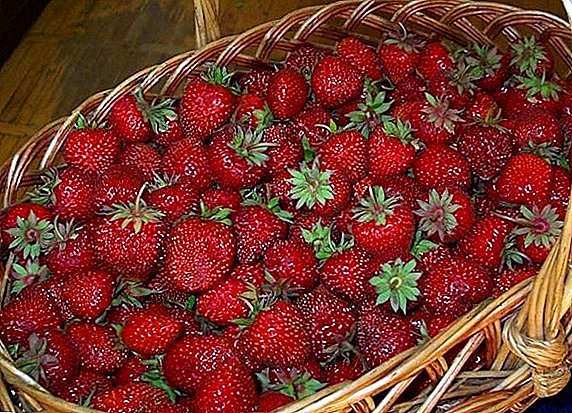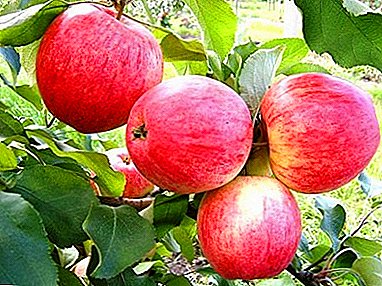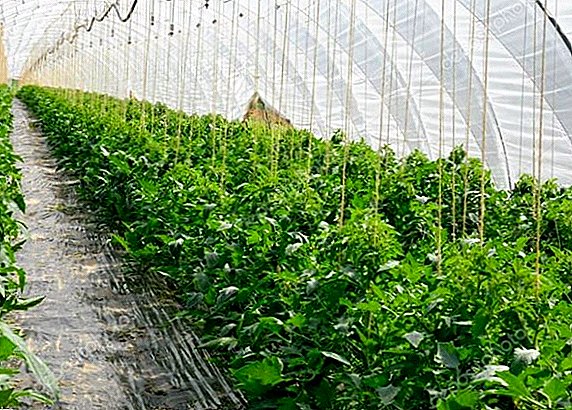 How many difficulties a gardener needs to overcome in order for fresh vegetables to appear on his desk! After all, planting tomatoes in the greenhouse requires a competent approach and delivers a lot of trouble. It is important to properly prepare the seeds and the beds, to disinfect, grow the seedlings, and then organize a competent care and maintenance regime of plants. But despite all these concerns, growing tomatoes in polycarbonate constructions is one of the most popular occupations of vegetable growers. What you need to know and be able to get a good harvest, how to plant tomatoes in the greenhouse - we will tell about it later in the article.
How many difficulties a gardener needs to overcome in order for fresh vegetables to appear on his desk! After all, planting tomatoes in the greenhouse requires a competent approach and delivers a lot of trouble. It is important to properly prepare the seeds and the beds, to disinfect, grow the seedlings, and then organize a competent care and maintenance regime of plants. But despite all these concerns, growing tomatoes in polycarbonate constructions is one of the most popular occupations of vegetable growers. What you need to know and be able to get a good harvest, how to plant tomatoes in the greenhouse - we will tell about it later in the article.
Greenhouse preparation
The conditions in which the crop will be grown are the most important factor in its resistance to diseases and pests. In the process of preparing the greenhouse, it is important to pay attention to the soil, microclimate and take disinfection measures. We will understand all the nuances in order.
Did you know? Initially, tomatoes were considered deadly berries. Our ancient ancestors were afraid of them in panic, and today culture has gained primacy in the number of production on all continents. For the year, people gather up to 60 million fruits from fields and beds of the planet.
Given the cold nights of the period when you need to plant tomatoes in the greenhouse, it is advisable to take care of additional shelter greenhouses. Often, for this purpose, use the usual polyethylene film, which is tensioned on the structure in 2 layers. Experienced growers recommend leaving an air cushion between them. This is done to create a favorable microclimate inside the building and to protect the internal coating. But remember that in the heat of the seedlings will not be able to fully develop, so ventilation windows should be provided on all sides.

If you plan to engage in the cultivation of tomatoes in the winter, take care of additional lighting beds. Without it, the plants will not bloom and bear fruit. In addition, a very crucial point is the disinfection of the room. It is irrigated with a weakly concentrated solution of potassium permanganate (at the rate of 1 g of the drug per 10 liters of water) immediately before planting.
Preparation of soil for planting
For a tomato bed an ideal loamy or sandy sandy breathable area, where in the previous year there were no solanaceous crops. Crop rotation is important because the microbes remaining in the earth are more likely to kill tomatoes.
Important! Long-term tomato cultivation at the same place contributes to soil oxidation. For its alkalization, experts advise to sprinkle known fuzz, dolomite flour or old plaster over the area. From 150 to 300 g of substance will be required per square meter.
In the autumn, after harvesting, experts advise to remove the remains of the tops from the garden and remove the ten-centimeter layer of top soil. Do not worry about throwing away the fertile part. It is important to do this for the prevention of the infection of vegetables with predecessor diseases. After that, the allotted area must be disinfected with a solution of copper sulphate, which is prepared in a ratio of 1 tablespoon to a bucket of water. After sprinkling, the area should be fertilized with minerals. For this purpose, potassium sulphate and superphosphate are recommended for tomatoes (20 g and 50 g per square meter, respectively).
Preparatory work can be done in the spring. But in this case, you need to start in March. A week before planting the seedlings of tomatoes in the greenhouse, the area should be properly loosened and cleaned from germinated weeds. Then, in order to compensate for the nutrients removed during the preparation of the earth, it is recommended to add humus. Its amount depends on the physicochemical characteristics of the substrate. On depleted areas for each square meter will need to pour about 8 kilograms of the substance and in addition a glass of charcoal. And on enriched soils, you can get by with 3 kilograms of humus.

Some gardeners share the experience of adding a mixture of river sand, peat and sawdust to the garden bed. It is noted that on loamy soils it is necessary to take all the components in half a bucket, and on peat bog it is necessary to replace the turf ground.
When to plant?
Terms of planting tomatoes in the greenhouse depend on the degree of warming of the soil and air, the condition of the seedlings and (let it not sound like superstition) recommendations of the Lunar Calendar. We will understand the nuances in stages.
Terms of planting seedlings
The presence of a greenhouse on the site allows you to get fresh fruit much earlier. And so that the harvest was rich, you need to guess over the time of planting. It depends on the material and design features. For example, in heated greenhouses, planting should take place at the end of April. But in rooms equipped with an additional internal covering layer of polyethylene, it is better to do this in the first weeks of May. The same timeframe is worth observing and when you plan to plant tomatoes in a polycarbonate greenhouse. If the structure does not provide additional shelter and heating installations, planting seedlings is better to do in the second half of May.
Important! If earlier in the greenhouse there were cases of tomato damage by late blight or other fungal diseases, next year, choose resistant hybrid varieties for planting. These include: "De Barao", "Opera F1", "Virtuoso F1", "Boheme F1", "Darnitsa F1", "Cardinal".
A good time for planting tomatoes depends largely on the climatic conditions of the region in which the site is located. Judge for yourself: in the southern regions in mid-May, it is already quite warm and tomatoes can be planted in ordinary unheated greenhouses even without a polyethylene backing, but in the northern zones during this period it is still cold and the long-awaited heat will come only closer to summer. In addition, it is important to focus on the state of the soil, as well as the air temperature in the greenhouse. Ideally, the earth should be heated to a stable 15 ° C, and the air to 20 ° C.

Signs and appearance
The presence of the above conditions is not a canon. After all, it often happens that the weather has long allowed for planting, and the seedlings are not yet ready. Therefore, it is important to plan all the work in such a way that the interaction of the necessary processes is obtained. Great potential in seedlings with well developed roots, thick and sturdy stem. It must have 8 true leaves and at least 2 floral brushes. Experts believe that forty-day tomatoes are ideal for polycarbonate greenhouses. Permissible to plant seedlings, which is about 50 days.
Did you know? The record holder is a three-kilogram giant grown on a Wisconsin farm in the United States of America.
Appeal to the lunar calendar
Some gardeners do not heed the advice of astrologers, and meanwhile, the moon is the most important factor influencing all life on the planet. Therefore, if you want to get hardy plants and even a bountiful harvest, do not be lazy to look into the lunar calendar. There you will find not only standard numbers, but also the phases of the Moon, and a list of recommended works on a specific date. Consider the recommendations of astrologers for 2018:
- 6.10 and January 30, it is best to sow tomato seeds for seedlings;
- 14.16, 18, 24, 26, 27 and 28 February, it is also possible to carry out the sowing of grains;
- March 3, 4, 10, 12, 20, 25, 30, 31 is the ideal period for all garden robots with tomatoes;
- April 8, 12,13, 22, 26, 27 and 28 are suitable days for transplanting tomato seedlings into greenhouses;
- May 9, 15, 19, 24,25 favorable for such procedures in cooler regions.

The most dysfunctional for any work on the tomato garden in 2018, astrologers call the phases of the New Moon and Full Moon. This is explained by the fact that the moon "is aging", and the vital energy of plants goes underground. During this period, even seemingly frivolous damage to the stems or roots of the seedlings can lead to its death. Experts say that the seeds planted during this period receive a program to develop underground. The result is a powerful rhizome and a nondescript weak tops. Root vegetables are ideal for this period, but not tomatoes.
Important! The main rule of planting tomatoes in the greenhouse or in the open field is in the space between the rows and bushes. In no case can not zagushchat landing, because then the bushes will suffer from a lack of sun and space for the proper formation of bushes.
How to plant tomatoes in the greenhouse?
Before you start planting tomatoes in the greenhouse, it is important to pay attention to the variety of seedlings. After all, the landing scheme depends on its height. For example, a chess fit with 2 rows and a half-meter distance between them is suitable for short-growing early maturing hybrids. Between the holes in the row it is desirable to leave up to 40 cm. Such tomatoes are best planted around the perimeter of the greenhouse.
For crops with limited growth, experts also advise a chess scheme with similar aisle, only between bushes you need to retreat up to 25 cm. Tall varieties can be planted in one or two stalks. The first method provides for aisle width up to 80 cm, and the distance between stems up to 60 cm. And the second option is carried out by increasing the intervals between adjacent bushes to 75 cm.

If you prefer to combine several varieties, do not forget to take into account the illumination of each of them - the neighbors should not create shadow and discomfort. Experienced vegetable growers place stunted fasteners along the edges of the structure, and tall giants are planted in the center (and preferably closer to the aisle).
Did you know? The myth of the toxicity of tomatoes was debunked by the American colonel Robert Gibbon. This happened in 1820, when a military man, in protest of a court decision right on the steps of one of the courts in New Jersey, ate a whole bucket of ripe juicy fruit. The man was hoping to get poisoned. A crowd of two hundred thousand gathered to see this spectacle. Some ladies fainted, while others called the doctors to be on duty near the brave man.
When you have decided on these nuances, you can proceed directly to the preparation of the landing holes. They are made up to a depth of 15 cm. Fertilizers are not applied as this was done during the preparation of the soil. If desired, half of a glass of wood ash can be poured into each well and watered with warm, well-settled water.
Also, for cultivation in greenhouse conditions, suitable varieties of tomatoes such as: "Sugar Bison", "Grandee", "Raspberry Giant", "Golden Domes", "Honey Drop", "Cosmonaut Volkov", "White Pour", "Novice "," Marina Grove "," Persimmon "
Planting seedlings should be carried out carefully, so as not to destroy the clod of earth and not to damage the stems. To do this, it must be moistened with plenty of water in advance. After that, place the seedlings in the pits and fill with fresh soil. Experts do not advise much bury plants. This will affect their further development and growth rates. But in order for the stems to grow strong, they need to be planted at an angle. Over time, additional roots will appear on the sprouts, which will contribute to the viability of the tomatoes.

Features care for seedlings
Well, you probably know that the correct planting your chores on a tomato garden will not end. After the rooting process, you can rest for 3-4 days without taking any action. And then begin watering, dressing, garters, pasynkovanie and, finally, harvesting.
Important! Pus for tomato beds is very harmful - many pathogenic microorganisms and larvae of harmful insects live in it, which will certainly entail diseases. Experts advise fertilizing plants with humus.
After the four-day adaptation period after planting, you can water the plants. Be aware that moisture should be abundant, but not frequent. Otherwise, moisture and heat very soon entail fungi and diseases. Do not drain the beds and irrigate regularly, because otherwise the risks of infection of the fruit with top rot increase.
After 5 days after planting the tomato seedlings, it is important to loosen the bed, and after 14 days the seedlings will need to live on with complex mineral fertilizers. During this period, young stalks need nitrogen, phosphorus and potassium.

If you prefer tall hybrids for planting, then a couple of weeks after rooting, they will need a garter to support. Otherwise, the shoots will break under the weight of their weight. But low-growing bushes in this procedure do not need, because they branch well, forming a neat dense crown.
When the plants reach a height of 25 cm, remove the appearing processes between the leaf cuttings and the stem. Experts advise to leave the only lower stepson. This is done in order to form a bush of 2 shoots. This is usually advisable in case of severe damage to the central shoot. Today, there are many early maturing hybrids that do not need to be staked at all. Consequently, less hassle.
Did you know? A whole controversy broke out in America over the botanical definition of tomatoes in the 90s of the 19th century. Scientists considered fruits as berries, consumers as fruits, and the Supreme Court of the United States of America - vegetables. The motivation for such a decision was justified by customs duties that imposed imported vegetables.
In the process of growing a tomato bed in a greenhouse, it is very important to periodically inspect the bushes for the development of symptoms of fungal diseases. If a similar pattern is found, the affected parts should be immediately removed and the plants treated with fungicides. Well proved: "Skor", "Fundazol", "Maxim".
Some avid vegetable growers pin great hopes on the greenhouse, not even suspecting that the slightest disturbances in the tomato cultivation technology can have a very modest yield. Knowing the subtleties and basic rules of planting seedlings and caring for it, you will be able to avoid serious mistakes.



